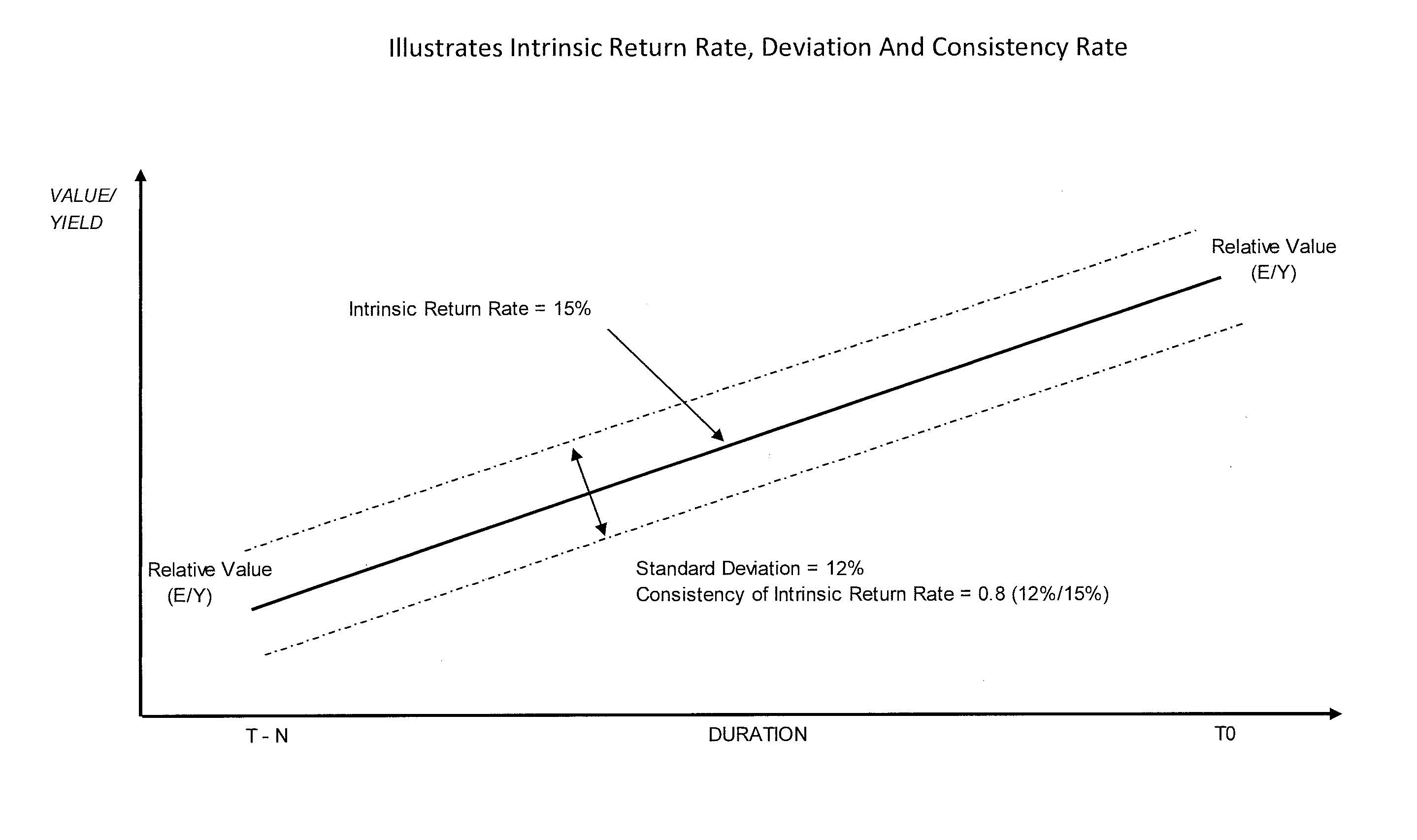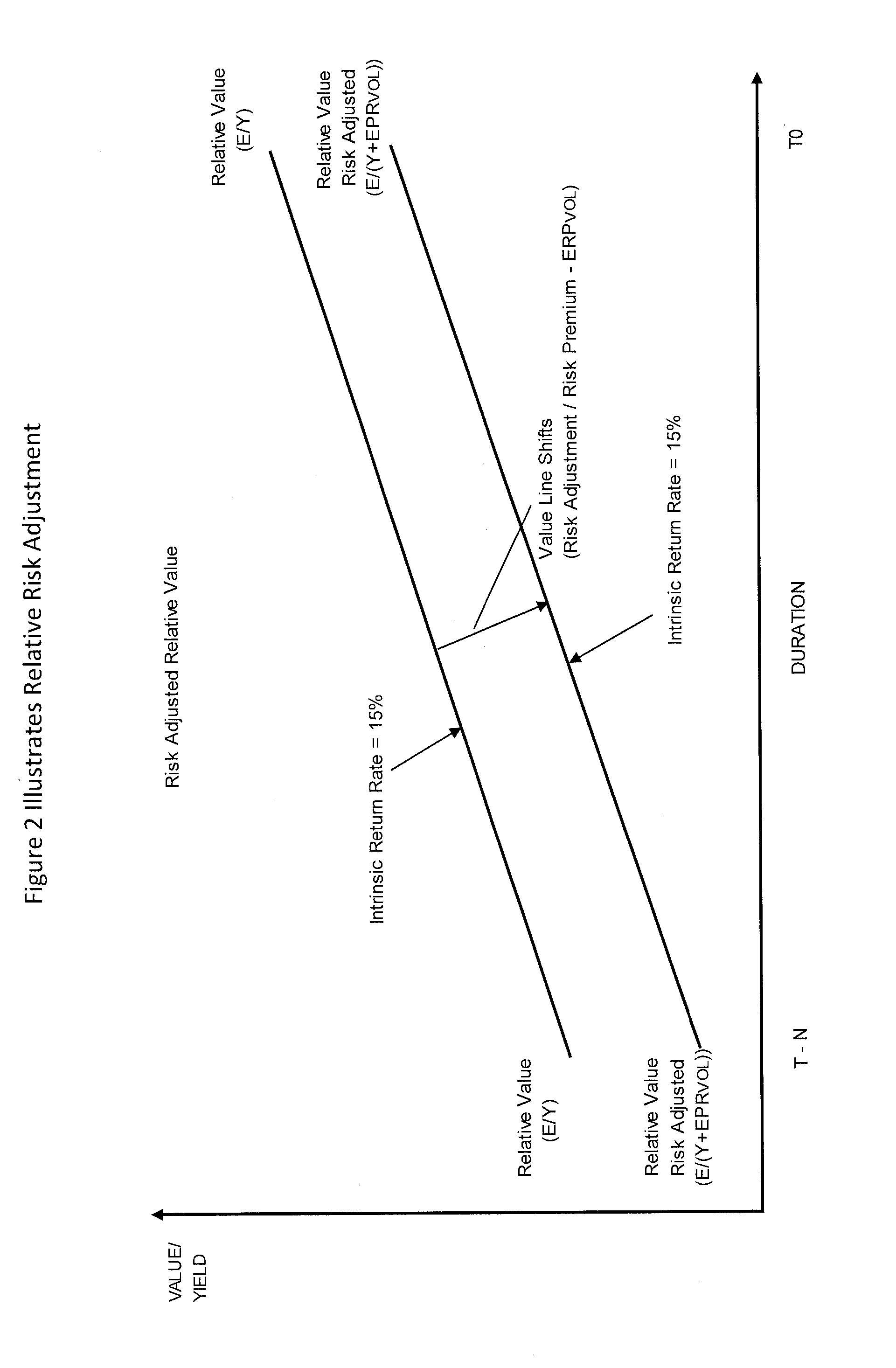Computer-Implemented Method For Portfolio Construction And Indexation Of Securities Under A Noisy Market Hypothesis
a technology of noisy market hypothesis and portfolio construction, applied in the field of cross-sectional analysis, can solve the problems of stock market rationality or efficiency, investment returns, unnecessary volatility, etc., and achieve the effect of high accuracy and predictabl
- Summary
- Abstract
- Description
- Claims
- Application Information
AI Technical Summary
Benefits of technology
Problems solved by technology
Method used
Image
Examples
example embodiments i
[0113]A risky assets (stocks) cash-flow is set in “volatility risk equilibrium” with a risk free assets cash flow (bond) when relative volatility risk has been considered and eliminated through a risk adjustment. In other words, a risk premium is added to the risk free rate to compensate for inconsistency (deviation or volatility) risk carried by the risky asset. This can be formulized as, ERAYRFA+ERPVOL), where E represents a risky assets (RA) earnings and Y represents the yield for a risk free asset (RFA) and where EPRVOL represents the risk premium based on earnings volatility risk.
[0114]A risky asset (stock) is fair valued when the risky assets risk adjusted relative value to a risk free asset (bond) is in equilibrium with the risky assets (stocks) market value.
[0115]Equilibrium can be formulated as ERA / (YB+ERPVOL)=P, where ERA is the risky assets (stock) earnings and YB represents the yield for a risk free asset, and where ERPVOL represents the risk premium based on demonstrate...
example embodiments ii
[0161]Provided herein is a system and method for determining profitability on stock investments. The method is generally described in an advantageous embodiment as provided below and further illustrated in FIGS. 1-3 and 5-8 while the system is generally illustrated and detailed in FIGS. 9-12.
[0162]The method may include four steps: 1) determining the fair value of a particular stock; 2) determining the annual compounding intrinsic return of the company; 3) determining the consistency of the intrinsic return; and 4) determining the current annual compounding rate of return on investment. Alternatively, it is contemplated that the step of determining consistency of the intrinsic growth may be performed during step 1, such that the step of determining a fair value of a particular stock takes into account the risk involved.
[0163]Primary Method, step one: Current Fair Value Determination. For this application, “fair value” is the relative value to the risk free rate of a Treasury Note. I...
example
[0182]RequiredInitialReturn=(20.9%26.5%)×4.7%+4.7%=8.4%RiskPremium=8.4%-4.7%=3.7%
[0183]For example, a standard deviation is 10%, the intrinsic return is 20% and the risk free rate is 5%. The new discount rate or initial return requirement is therefore: (0.5*5%)+5%=7.5% (risk premium is 2.5%). If a company's last reported or trailing Earnings Per Share (EPS) is $10, then the new (risk adjusted) fair value would be $10 divided by 7.5% =$133. It can be seen that the new fair value is now discounted to reflect a 100% consistent (e.g. standard deviation=0) performance record. By calculating and adding a risk premium it becomes possible to compare companies in a population on a risk adjusted basis. This makes stocks comparable to a benchmark e.g. the (risk free rate), which has a standard deviation of “0” when held to maturity. Risk is the volatility in the year by year growth records of the intrinsic return.
[0184]It should be noted, however, that other alternative measurements and adjust...
PUM
 Login to View More
Login to View More Abstract
Description
Claims
Application Information
 Login to View More
Login to View More - R&D
- Intellectual Property
- Life Sciences
- Materials
- Tech Scout
- Unparalleled Data Quality
- Higher Quality Content
- 60% Fewer Hallucinations
Browse by: Latest US Patents, China's latest patents, Technical Efficacy Thesaurus, Application Domain, Technology Topic, Popular Technical Reports.
© 2025 PatSnap. All rights reserved.Legal|Privacy policy|Modern Slavery Act Transparency Statement|Sitemap|About US| Contact US: help@patsnap.com



